| Strategy | Luck |
|---|---|
| Interaction | Components & Design |
| Complexity | Score |
The players in Die Quacksalber von Quedlinburg are charlatans selling their potions and tinctures at the annual fair in Quedlinburg. At least, they will sell them if they manage to make them without blowing up their kettle. Spoiler: they won’t. Not reliably. The possibility of your kettle exploding is the fun. And the best part: when it does explode you have no one to blame but yourself.
Cooking with Snake Oil 101 – The Rules
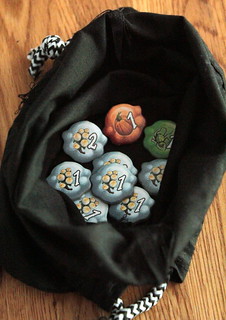
Quacksalber combines two game mechanisms that seem made for each other: bag building and press your luck. The bag has all your potion ingredients. You buy ingredients to put in the bag. When you brew a potion you keep drawing ingredients from the bag until you decide to stop or until you draw too many snowberries to your kettle. In that case it explodes. (The explosion makes a lot more sense in German where the Common Snowberry is called Knallerbse, a word that literally means Banging Pea and is also used for cap bombs.)
Which ingredients you throw into your kettle isn’t too important for the outcome. There is no recipe to complete. What’s important is how many ingredients you fit in there before it blows and what quality they have. Making a potion goes like this: you draw an ingredient chip from your bag and put it in your kettle. The quality of the ingredient – the number printed on it – tells you how many spaces ahead of the last ingredient you may place it. Better ingredients fill your kettle faster. Beyond filling your kettle most ingredients have a special effect, and that’s where the bag building part becomes important.
What the ingredients do varies from game to game. White snowberries are always an explosion hazard, so it’s unfortunate our starting bag mostly has those. Orange pumpkins are a simple filler ingredient with no special function and black death’s head moths give a reward to the player who has the most of them in the kettle. The five remaining colors each have four different options what they might do.
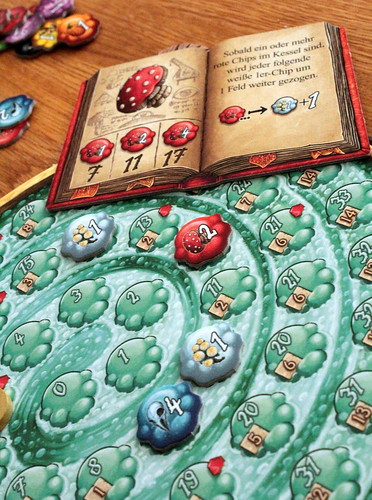
Red toadstools, blue crow skulls and yellow mandrakes always have an immediate effect when you put them in the kettle. For example, one variant of toadstool becomes more valuable when put in the kettle immediately after a snowberry. Another kind of toadstool can be set aside when you draw it from the bag and used later, even in a later round. The remaining colors do something at the end of the round.
Mixing potions demands some fairness from the players. Everyone mixes their potion at once, so no one is going to watch closely what you do. Don’t just put snowberries back in the bag, please. Also, try not to stare at your opponents’ kettles. You’re not supposed to look how far they got already before you decide to give up or keep going.
When all players have decided to stop – or, more hilariously, blew up their concoction – you go through the stages of scoring. First the player who filled their kettle the most without going boom gets a reward from the bonus dice. Then all players take the actions from their green, purple, and black ingredient chips. All players who finished on a ruby space in their kettle get, you guessed it, a ruby. And now comes the really evil part. Players who didn’t blow up score points based on how full their kettle is, then they buy new ingredients on the same basis. Players who did blow up must decide: points, or new ingredients? That’s a really tough decision. Don’t score one round and you fall behind in points. Don’t buy ingredients and everyone else will have a fuller kettle than you.
No matter what you choose, blowing up is pretty bad, but Die Quacksalber von Quedlinburg has a good catch up mechanism. Between many spaces on the victory point track there are little rats. For each rat between you and the leader you place your rat token one space forward in your kettle. You start placing your ingredient tiles ahead of that token, so being behind grants you a head start.
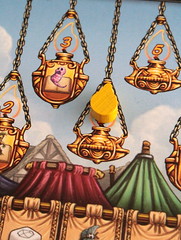
That’s not the only way for free kettle advancement. Remember those rubies you got in scoring? One use for them is to move your start token in the kettle forward for two rubies. Or you could use them to reactivate your emergency flask, a useful tool that can return a snowberry to your bag once.
You do all that for nine rounds before the game ends. That sounds a lot, but remember that players do pretty much everything in Die Quacksalber von Quedlinburg at the same time. The forty-five minutes play time on the box are entirely realistic.
Medicine or Snake Oil – The Verdict
Die Quacksalber von Quedlinburg is a bit of a mixed bag. Get it? Mixed bag, bag building game… okay, that joke was bad, nevermind. The basic mix of mechanisms is excellent. The press your luck part does exactly what you want it to do. It drives up your adrenaline with every ingredient chip you pull from the bag. It brings cold sweat to your forehead when you know the three point snowberry will kill you. And that feeling doesn’t go away. Just when you padded your bag with a few beneficial ingredients the game forces you to add another snowberry in round six.
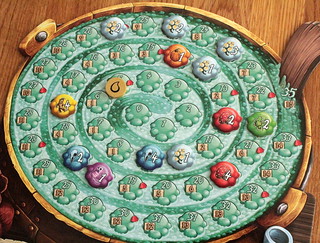
At the same time you have a strategic decisions to make when adding ingredients to your bag. Which ingredient effects will be more valuable? Something to make you safer from explosions? Something for extra points? Do you buy one expensive ingredient because you like the effect better, or two cheap ones to pad your bag. I had my doubts at first about the balance of ingredient effects: Some just seem stronger than others. Then I got my ass soundly kicked a few times by players buying those “inferior” ingredients and had to admit that they are more balanced than I thought.
All good so far, but not everything is gold and glitter. One thing Quacksalber lacks is interaction. There are the black ingredient chips where the player with the most of them gets a benefit. Besides that, the only influence their game has on mine is if they score more points or fewer than me. I have played games that were more “multiplayer solitaire”, however, and I didn’t complain. For a long time I couldn’t put my finger on what was it about Quacksalber that made me notice it more. Then I remembered that deep down I’m a bad person. My problem is that I didn’t get to enjoy my schadenfreude. Half the fun in press your luck games is watching others press their luck and fail. Missing that because you were staring at your own kettle, that’s like opening the oven before the souffle is finished. That alone is reason enough to use the optional rule that all players draw one ingredient at the same time, then they decide if they want to keep going, then they all draw the next. It gives you a chance to see when your opponents are digging their own grave. Trust me, you want to see it.
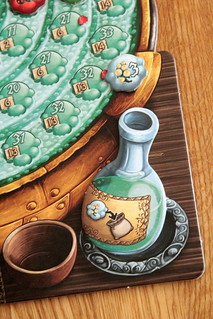
That was some perceived problems that turned out not to be problems at all. There is one issue that I still think is legit, though. I don’t think the catch-up mechanism is quite enough. Getting some bonus spaces in the kettle is nice, but once a player is behind in points he still has to take more risks, is more likely to explode than the leader, and will fall further behind. In our test games it was a rare event that someone caught up with a leader by four or more points. I think a penalty for the leading player would have worked better than a bonus for the trailing ones, but our attempts at house-ruling it didn’t work out either.
So that’s one problem that didn’t disappear on closer observation. It doesn’t change the most important thing, however: that Die Quacksalber von Quedlinburg is fun. The mix of strategy, tactics and luck is addictive. With the different options for ingredient effects you also get a good amount of replayability. I might quibble – yet again – if Quacksalber belongs in the Kennerspiel des Jahres category or should be on the list for Spiel des Jahres. But that’s a dispute between me and the jury, the game didn’t do anything wrong. Although Die Quacksalber von Quedlinburg is not quite the panacea of games, but it’s no snake oil, either.












